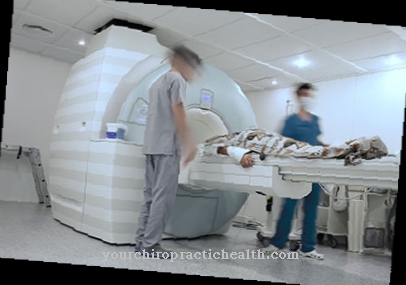As Right ventricular hypertrophy is a pathologically strengthened heart muscle of the right ventricle. While a limited cardiac muscle strengthening within cardiovascular training leads to an increase in the performance of the heart, the performance decreases again in the case of hypertrophy of the heart muscle due to the increasing rigidity of the affected walls. In right heart hypertrophy, the pulmonary circulation, also called the small bloodstream, is affected.
What is right ventricular hypertrophy?

© olive1976 - stock.adobe.com
To a certain extent, strengthening the heart muscle throughout the heart, which can be achieved through cardiovascular training, leads to an increase in performance. Only when the stimulus for the growth of the heart muscle in the right or left ventricle continues, right or left heart hypertrophy occurs. The Right ventricular hypertrophy is manifested by a pathological increase in the muscle tissue of the right ventricle.
The heart wall in the area of the right ventricle is greatly thickened and interspersed with fibrous tissue. As a result, the heart muscle becomes inelastic and the capillary blood supply cannot fully follow the greater demand for oxygen, so that an additional oxygen supply to the smooth muscle cells of the heart muscle occurs. The increasing stiffness of the heart muscle in connection with the oxygen deficiency leads to a reduction in the performance of the heart in right heart hypertrophy.
The pulmonary circulation, also known as the small bloodstream, is initially affected by the impaired ejection capacity of the right ventricle, because the blood in the right ventricle is pumped into the pulmonary artery via the open pulmonary valve during contraction (systole).
causes
The most common cause of right ventricular hypertrophy is left ventricular failure. Due to a reduced ejection capacity of the left ventricle, which pumps the blood via the aortic valve into the large bloodstream or body circulation during systole, there is a backlog in the pulmonary circulation. The resulting increased pressure in the pulmonary artery triggers the stimulus to increased pumping in the right ventricle.
However, since this does not solve the problem of back pressure, the right ventricle's incentive to increase performance remains and a gradual hypertrophy sets in. Right ventricular hypertrophy can also be caused by partial obstruction of the lungs. Pulmonary emphysema, tuberculosis or diffuse pulmonary fibrosis can lead to an obstruction of part of the pulmonary circulation. This leads to an increase in vascular resistance in the pulmonary artery, called pulmonary arterial hypertension.
Similar to the back pressure caused by left heart failure, the right ventricle initially reacts with increased power, but this does not solve the problem. Therefore, hypertrophication gradually develops. Other causes can be pulmonary valve stenosis or a ventricular septal defect. In both cases, the right ventricle “tries” to compensate for the reduced supply to the aorta during systole by increasing its output, which then gradually triggers hypertrophication.
A very rare cause is the Fallot tetralogy, a genetic malformation of the heart. It manifests itself in the four simultaneous defects of narrowing the entrance to the pulmonary artery - comparable to pulmonary stenosis, incomplete closure of the cardiac septum between the two chambers, misplaced aortic entrance and the resulting hypertrophy. Even prolonged stays at extreme altitudes can lead to right heart hypertrophy.
Symptoms, ailments & signs
An incipient right heart hypertrophy is initially symptom-free and uncomfortable. Only when the right ventricle's ejection capacity declines (diastolic dysfunction) do the first signs of shortness of breath appear during physical exertion. Usually a non-specific, general tiredness and weakness become noticeable beforehand, which can be attributed to the chronic lack of oxygen supply (hypoxia).
Blood congestion can develop in the digestive tract, which leads to impaired digestion and a reduced ability to absorb nutrients in the small intestine. Impairments of certain liver functions can also occur. Externally visible signs are a greenish-blue discoloration of the skin and mucous membranes (cyanosis). In some cases, tissue fluid accumulates (edema) and congestion occurs in the neck veins.
Diagnosis & course of disease
Right heart hypertrophy can be recognized by means of an ultrasound examination (echocardiography). The EKG also allows conclusions to be drawn about the function of the heart. If necessary, magnetic resonance imaging (MRI) provides further findings and knowledge about the progress or the severity of the disease. In more advanced stages, chest pain that is comparable to that of angina pectoris occurs.
Right ventricular hypertrophy can also trigger an arrhythmia or even cause a heart attack. The disease progresses in severity unless the cause of the hypertrophication is found or treated.
Complications
Right heart hypertrophy is initially symptom-free, but is always associated with long-term consequences. In the course of the disease, shortness of breath develops, which mainly occurs during physical exertion and which significantly limits the everyday life of the person concerned. The fatigue that typically occurs develops into physical exhaustion, which is also associated with restrictions in everyday life and professional life.
Occasionally, blood congestion occurs in the digestive tract, which results in impaired digestion and a reduced ability to absorb nutrients in the small intestine. In the long term, liver functions are also impaired, which are accompanied by edema, cyanosis and other complaints. The treatment usually uses diuretics, which may cause side effects.
Possible symptoms include dizziness, headache, muscle cramps and a rash. In individual cases, the drug promotes joint diseases such as gout as well as impotence and menstrual cramps. If right heart hypertrophy is treated surgically, i.e. if an artificial heart valve is used, this is always a great burden for the organism.
Possible complications are atrial fibrillation, bleeding, infection, stroke and temporary psychological complaints. Undetected previous illnesses can lead to heart failure.
When should you go to the doctor?
Right ventricular hypertrophy should always be treated by a doctor. In the worst case scenario, this disease can lead to death if the right heart hypertrophy is not treated in good time. The doctor should then be consulted if severe breathing difficulties arise. These can occur especially in strenuous or stressful situations and have a very negative effect on the patient's quality of life. Furthermore, severe shortness of breath suggests right ventricular hypertrophy and should be examined.
Severe tiredness can also indicate the disease. The patients often suffer from impaired digestion and cannot ingest food and fluids without complaints. In severe cases, right ventricular hypertrophy can also lead to cyanosis. In this case, an emergency doctor should be called immediately or the hospital should be visited directly. In general, right heart hypertrophy is treated by a cardiologist. However, surgery may also be necessary.
Therapy & Treatment
The focus of treatment and therapy for right heart hypertrophy is the treatment of the abnormality or disease that caused the hypertrophy. In many cases this means that the increased pulmonary pressure has to be reduced in order to deprive the right ventricle of the incentive to compensate for the insufficient blood flow in the pulmonary artery.
Diuretics can support the process because, in the case of edema or pulmonary emphysema, they help flush the accumulated tissue fluid through the kidneys in order to reduce the central venous pressure. In other cases where mitral or pulmonary valve insufficiency is present, implanting an artificial heart valve can be the solution to the problem.
prevention
Preventive measures to prevent right ventricular hypertrophy can only consist of the prevention or prevention of disease states that have right ventricular hypertrophy as secondary damage. This means that the occurrence of unspecific symptoms such as chronic fatigue, insufficient physical performance and frequent blue discoloration of the lips and extremities should be clarified.
If no correct cause or explanation for the symptoms can be found, a cardiological investigation using an EKG and echocardiography is recommended in order to be able to counteract this as early as possible - if possible before the hypertrophy manifests itself.
Aftercare
In most cases, the affected person has only limited follow-up measures available for right heart hypertrophy, as this is a rare disease. If the disease has been present since birth, it usually cannot be completely cured.Therefore, if the person concerned wants to have children, they should undergo genetic testing and counseling in order to prevent the disease from recurring.
As a rule, there can be no independent healing. Most of those affected are dependent on taking various medications, always paying attention to the correct dosage and regular use. If you have any questions or are unclear, a doctor should always be contacted first, and the doctor should also be consulted in the event of side effects.
Regular checks by a doctor are also very important. If the disease is treated with an operation, the person affected should take it easy after the operation and especially protect the affected area. This can prevent infection and inflammation. In many cases, right heart hypertrophy also limits the life expectancy of the person affected, although a general course cannot be predicted.
You can do that yourself
Patients with right heart hypertrophy should pay attention to the signs of their organism. Physical exertion or situations of overload lead to rapid fatigue and rapid exhaustion. The person concerned should take breaks and completely avoid the occurrence of heavy stress. Intensive sports activities should not be practiced.
The leisure activities are to be adapted to the possibilities of the organism. Stress or emotional disruptive factors must be reduced early on. It is helpful to practice relaxation techniques such as yoga or meditation. In addition, mental training sessions help to strengthen the mind. Conflicts with other people should be resolved as quickly as possible and should not be intensified. Cognitive techniques help to change one's own behavior and to avoid situations of confrontation with other people. In professional life it is important to ensure that neither physical nor mental limits are exceeded.
In everyday life the patient has to learn to react to his own physical signals. The development of positive stimuli is important for promoting well-being and quality of life. Hobbies and leisure activities should be geared towards strengthening the zest for life. This relieves stress and supports health.
In addition, it must be ensured that the body's own weight is within the normal range of the BMI. Any excess weight can be reduced by changing and optimizing the food intake.




.jpg)

.jpg)




















